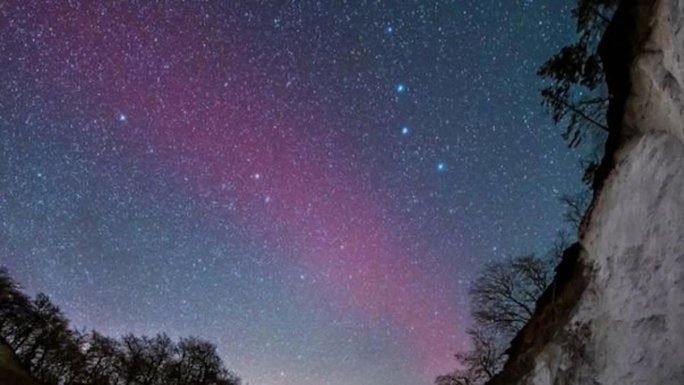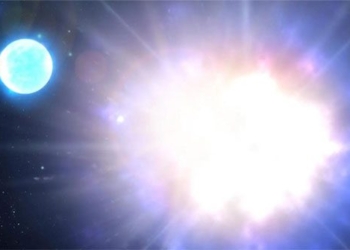A bright red streak, resembling blood and almost like a demonic arc or a river of blood flowing through the sky, has caused panic among many residents in the Scandinavian Peninsula. Scientists have confirmed that it is not an aurora borealis.
According to Space, the streak has been described as a river of blood-red light, ethereal, stretching across the night sky, appearing in some places like a rainbow arc but in a single color.
This phenomenon appeared last week, coinciding with the strongest geomagnetic storm to hit Earth in six years. In the United States, pink lights were also observed, believed to be a strange type of aurora. However, recent analysis confirms that the “river of blood” observed from Northern Europe is not an aurora borealis.

A part of the “river of blood” appearing in the sky over Møns Klint, a collection of limestone cliffs on the island of Møn in Denmark in the Baltic Sea – (Photo: Astronomical photographer Ruslan Merzlyakov)
According to analysis by scientists from Spaceweather.com, this unusual phenomenon is referred to as “Stable Auroral Red Arc” (SAR), and despite its name—which may have been given based on initial misinterpretations of this phenomenon—it is not an aurora and is not necessarily stable.
The eerie “river of blood” is light emitted by oxygen molecules in the upper atmosphere, heated by the Earth’s ring current, a massive electrical current surrounding the planet.
The geomagnetic storm occurred and created real auroras. During this aurora event, high-energy particles from the solar wind and the plasma sphere it ejects into Earth’s magnetosphere excite gas molecules in the upper atmosphere, causing a variety of phenomena, including spiraling lights of different colors due to various atoms being stimulated.
For SAR, the stimulated element is oxygen, which is heated by the surrounding ring current, glowing like an aurora but with a frightening red hue.
SAR observed in Northern Europe—most clearly from Denmark—is not the only unusual light display seen during the recent massive storm. A phenomenon similar to STEVE—a purple light band, which is also not an aurora—was also seen hanging in the skies over the United States and the United Kingdom.





















































